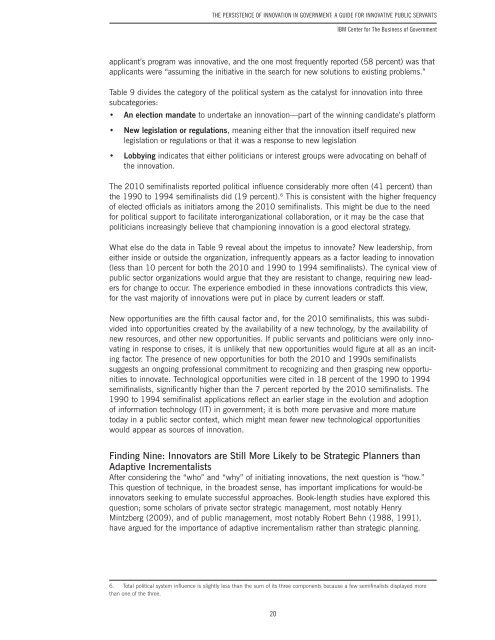The Persistence of Innovation in Government
The Persistence of Innovation in Government
The Persistence of Innovation in Government
- No tags were found...
You also want an ePaper? Increase the reach of your titles
YUMPU automatically turns print PDFs into web optimized ePapers that Google loves.
<strong>The</strong> <strong>Persistence</strong> <strong>of</strong> <strong>Innovation</strong> <strong>in</strong> <strong>Government</strong>: A Guide for Innovative Public ServantsIBM Center for <strong>The</strong> Bus<strong>in</strong>ess <strong>of</strong> <strong>Government</strong>applicant’s program was <strong>in</strong>novative, and the one most frequently reported (58 percent) was thatapplicants were “assum<strong>in</strong>g the <strong>in</strong>itiative <strong>in</strong> the search for new solutions to exist<strong>in</strong>g problems.”Table 9 divides the category <strong>of</strong> the political system as the catalyst for <strong>in</strong>novation <strong>in</strong>to threesubcategories:• An election mandate to undertake an <strong>in</strong>novation—part <strong>of</strong> the w<strong>in</strong>n<strong>in</strong>g candidate’s platform• New legislation or regulations, mean<strong>in</strong>g either that the <strong>in</strong>novation itself required newlegislation or regulations or that it was a response to new legislation• Lobby<strong>in</strong>g <strong>in</strong>dicates that either politicians or <strong>in</strong>terest groups were advocat<strong>in</strong>g on behalf <strong>of</strong>the <strong>in</strong>novation.<strong>The</strong> 2010 semif<strong>in</strong>alists reported political <strong>in</strong>fluence considerably more <strong>of</strong>ten (41 percent) thanthe 1990 to 1994 semif<strong>in</strong>alists did (19 percent). 6 This is consistent with the higher frequency<strong>of</strong> elected <strong>of</strong>ficials as <strong>in</strong>itiators among the 2010 semif<strong>in</strong>alists. This might be due to the needfor political support to facilitate <strong>in</strong>terorganizational collaboration, or it may be the case thatpoliticians <strong>in</strong>creas<strong>in</strong>gly believe that champion<strong>in</strong>g <strong>in</strong>novation is a good electoral strategy.What else do the data <strong>in</strong> Table 9 reveal about the impetus to <strong>in</strong>novate? New leadership, fromeither <strong>in</strong>side or outside the organization, <strong>in</strong>frequently appears as a factor lead<strong>in</strong>g to <strong>in</strong>novation(less than 10 percent for both the 2010 and 1990 to 1994 semif<strong>in</strong>alists). <strong>The</strong> cynical view <strong>of</strong>public sector organizations would argue that they are resistant to change, requir<strong>in</strong>g new leadersfor change to occur. <strong>The</strong> experience embodied <strong>in</strong> these <strong>in</strong>novations contradicts this view,for the vast majority <strong>of</strong> <strong>in</strong>novations were put <strong>in</strong> place by current leaders or staff.New opportunities are the fifth causal factor and, for the 2010 semif<strong>in</strong>alists, this was subdivided<strong>in</strong>to opportunities created by the availability <strong>of</strong> a new technology, by the availability <strong>of</strong>new resources, and other new opportunities. If public servants and politicians were only <strong>in</strong>novat<strong>in</strong>g<strong>in</strong> response to crises, it is unlikely that new opportunities would figure at all as an <strong>in</strong>cit<strong>in</strong>gfactor. <strong>The</strong> presence <strong>of</strong> new opportunities for both the 2010 and 1990s semif<strong>in</strong>alistssuggests an ongo<strong>in</strong>g pr<strong>of</strong>essional commitment to recogniz<strong>in</strong>g and then grasp<strong>in</strong>g new opportunitiesto <strong>in</strong>novate. Technological opportunities were cited <strong>in</strong> 18 percent <strong>of</strong> the 1990 to 1994semif<strong>in</strong>alists, significantly higher than the 7 percent reported by the 2010 semif<strong>in</strong>alists. <strong>The</strong>1990 to 1994 semif<strong>in</strong>alist applications reflect an earlier stage <strong>in</strong> the evolution and adoption<strong>of</strong> <strong>in</strong>formation technology (IT) <strong>in</strong> government; it is both more pervasive and more maturetoday <strong>in</strong> a public sector context, which might mean fewer new technological opportunitieswould appear as sources <strong>of</strong> <strong>in</strong>novation.F<strong>in</strong>d<strong>in</strong>g N<strong>in</strong>e: Innovators are Still More Likely to be Strategic Planners thanAdaptive IncrementalistsAfter consider<strong>in</strong>g the “who” and “why” <strong>of</strong> <strong>in</strong>itiat<strong>in</strong>g <strong>in</strong>novations, the next question is “how.”This question <strong>of</strong> technique, <strong>in</strong> the broadest sense, has important implications for would-be<strong>in</strong>novators seek<strong>in</strong>g to emulate successful approaches. Book-length studies have explored thisquestion; some scholars <strong>of</strong> private sector strategic management, most notably HenryM<strong>in</strong>tzberg (2009), and <strong>of</strong> public management, most notably Robert Behn (1988, 1991),have argued for the importance <strong>of</strong> adaptive <strong>in</strong>crementalism rather than strategic plann<strong>in</strong>g.6. Total political system <strong>in</strong>fluence is slightly less than the sum <strong>of</strong> its three components because a few semif<strong>in</strong>alists displayed morethan one <strong>of</strong> the three.20


